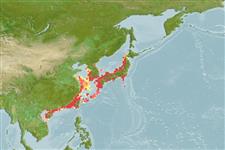Environment: milieu / climate zone / depth range / distribution range
Οικολογία
Θαλασσινό(ά) βενθοπελαγικό; εύρος βάθους 7 - 64 m (Ref. 11439), usually 10 - 18 m (Ref. 11439). Subtropical
Northwest Pacific: Japan to Taiwan.
Μέγεθος / Βάρος / Age
Maturity: Lm ? range ? - ? cm
Max length : 27.5 cm TL αρσενικό/απροσδιόριστο; (Ref. 126280); μεγ. δημοσιευμένο βάρος: 425.50 g (Ref. 126280)
Found near shore, down to 120 m on sand or sandy mud bottoms (Ref. 11230).
Life cycle and mating behavior
Maturities | Αναπαραγωγή | Spawnings | Egg(s) | Fecundities | Προνύμφες
Pietsch, T.W. and R. Kishimoto, 1989. Uranoscopus chinensis Guichenot, in Sauvage, 1882, a senior synonym of Uranoscopus flavipinnis Kishimoto, 1987 (Teleostei: Uranoscopidae). Copeia 1989(3):748-750. (Ref. 39351)
IUCN Red List Status (Ref. 130435)
Threat to humans
Harmless
Human uses
αλιεία: χωρίς ενδιαφέρον
Εργαλεία
Special reports
Download XML
Διαδικτυακές πηγές
Estimates based on models
Preferred temperature (Ref.
123201): 17.9 - 26.8, mean 22.8 °C (based on 268 cells).
Phylogenetic diversity index (Ref.
82804): PD
50 = 0.5000 [Uniqueness, from 0.5 = low to 2.0 = high].
Bayesian length-weight: a=0.00813 (0.00426 - 0.01550), b=3.10 (2.93 - 3.27), in cm total length, based on LWR estimates for this species & Genus-body shape (Ref.
93245).
Τροφικό Επίπεδο (Ref.
69278): 4.1 ±0.7 se; based on size and trophs of closest relatives
Ελαστικότητα (Ref.
120179): Μεσαίο(α), ελάχιστος χρόνος για διπλασιασμό πληθυσμού 1,4 - 4,4 έτη (Preliminary K or Fecundity.).
Fishing Vulnerability (Ref.
59153): Low vulnerability (18 of 100).
